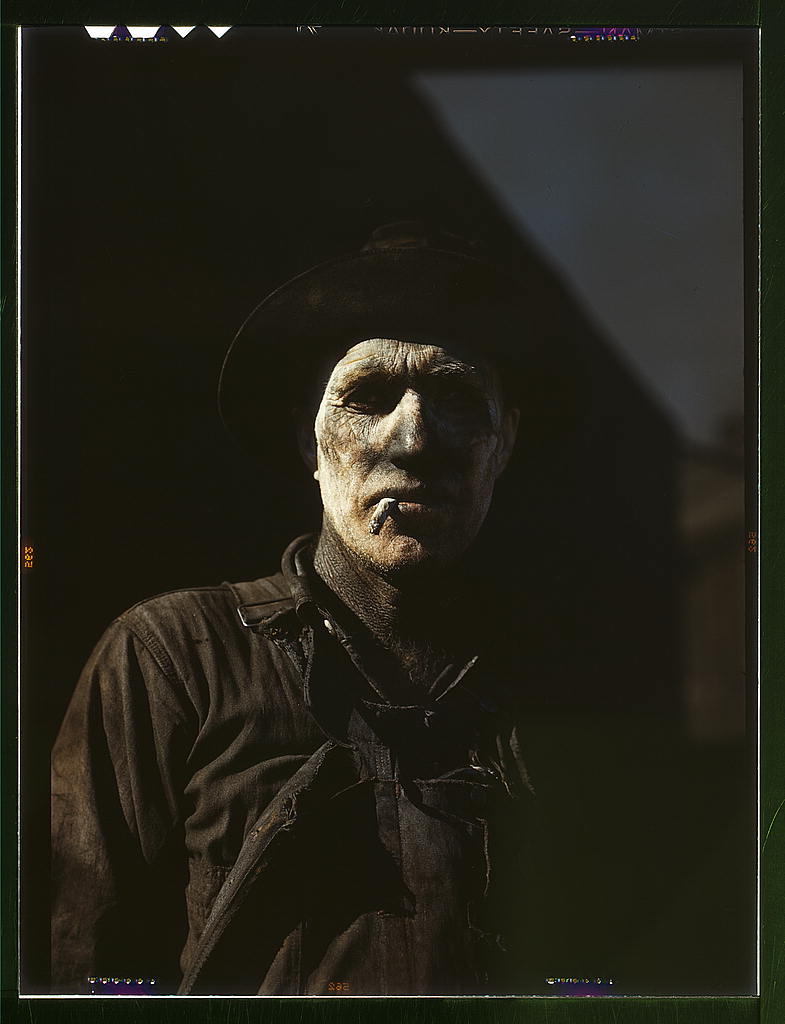.

Worker at carbon black plant, Sunray, Texas
This afternoon I worked in a carbon black plant. Do you know what a carbon black plant is? It's where they burn natural gas with insufficient oxygen and make carbon which is powdery black stuff in big bags worth 3 cents a pound, used in making tires, paints, & numerous other places.
The [Texas] panhandle is the seat of the carbon black industry, and on any given day in any given spot you can look all around you and in 6 or 7 corners 40 miles away, no fooling, you see little black places above the horizon. These are the C.B. plants. Then as you get nearer, naturally, the little black place gets bigger and bigger. From 5 or 10 miles it's a huge black cloud out there ahead of you. Then you drive right up to it and it's just exactly like driving from a sunny day into the middle of night.
They make wonderful backgrounds for pictures for quite some distance, and look exactly like dust storms I've seen pictures of, and I'll bet that's just what they were mistaken for by some dumb FSA photographers I could mention.
The one I worked in today had 300 what they call hot houses. Each hot house has several hundred gas jets burning. I went in one that was off, then they turned it on for me and I got a picture before it got very hot and got out. It's a beautiful weird sight inside. High mass.
Anyway, in working there, I got dirtier, that is blacker, than I have ever been in my life. Really black all over. Right through the clothes it goes. I washed carefully my face and hands, but I'm leaving the rest for a while, it's really kind of beautiful. It gets very shiny when you rub it.
Anyway, in working there, I got dirtier, that is blacker, than I have ever been in my life. Really black all over. Right through the clothes it goes. I washed carefully my face and hands, but I'm leaving the rest for a while, it's really kind of beautiful. It gets very shiny when you rub it.
About the best pictures I got this year, I think, will prove to be the portraits of some of the black faced workers there. I got so excited about these guys that I shot up all the film I had with me, and didn't get pix of the buildings, and various operations. So I'll have to go back again. And I'll sure make some more of those portraits.
John Vachon (1914-1975), letter to his wife Penny, 11 November 1942, from John Vachon’s America: Photographs and Letters from the Depression to World War II: John Vachon, ed. Miles Orvell, 2003

Worker at carbon black plant, Sunray, Texas

Worker at carbon black plant, Sunray, Texas

Workers at carbon black plant, Sunray, Texas

Sacking carbon black in plant, Sunray, Texas; carbon black is worth 3 1/2 cents a pound

Worker at carbon black plant with cream spread on his face to protect it from black dust, Sunray, Texas

Worker at carbon black plant, Sunray, Texas

Worker at carbon black plant, Sunray, Texas

Employee at carbon black plant, Sunray, Texas

Workers at carbon black plant, Sunray, Texas

Foreman of carbon black plant, Sunray, Texas

Carbon black plant worker getting a drink of water, Sunray, Texas

Turning on the gas in carbon black plant, Sunray, Texas

Carbon black plant workers washing up at the end of the day, Sunray, Texas

Carbon black plant worker taking a shower at the end of the day, Sunray, Texas

Separator tanks through which natural gas from the Panhandle fields enters the carbon black plant, Sunray, Texas

Carbon black plant, Sunray, Texas: gas is burned in 350 of these long low buildings called "doghouses"

Carbon black plant, Sunray, Texas: gas is burned in 350 of these long low buildings called "doghouses"

Carbon black plant, Sunray, Texas

Drying at carbon black plant, Sunray, Texas

Bags of carbon black at plant, Sunray, Texas

Bags of carbon black at plant, Sunray, Texas

Well on the pump, vicinity of Sunray, Texas: photo by John Vachon, November 1942
(Carbon black is a form of amorphous carbon produced by the incomplete combustion of heavy petroleum products such as FCC tar, coal tar, ethylene cracking tar & c. It is employed as a pigment and reinforcement in rubber and plastic products, most commonly as a pigment and reinforcing phase in automobile tires. In tire production it is used to conduct heat away from the tread and belt area of the tire, thus reducing thermal damage and increasing tire life. The International Agency for Research on Cancer has determined carbon black to be possibly carcinogenic to humans. Short-term exposure causes mechanical irritation to the human upper respiratory tract, producing local discomfort.)
Carbon black, aka Acetylene black, Channel black, Furnace black, Lamp black, Thermal black. TWA 3.5 mg/m3 Ca TWA 0.1 mg PAHs/m3 [Carbon black in presence of polycyclic aromatic hydrocarbons (PAHs)]. Black, odorless solid, insoluble. Combustible solid that may contain flammable hydrocarbons. Incompatibilities & reactivities: strong oxidizers such as chlorates, bromates & nitrates. Exposure routes: inhalation, skin and/or eye contact. Symptoms: cough; irritation eyes; [in presence of polycyclic aromatic hydrocarbons: potential occupational carcinogen]. Target organs: respiratory system, eyes. Cancer site: [lymphatic cancer (in presence of PAHs)]. Recommendations: prevent eye contact; wash skin daily.
from Pocket Guide to Chemical Hazards (Center for Disease Control and Prevention, National Institute for Occupational Safety and Health)
Photos by John Vachon, Sunray, Texas, November 1942 (Farm Security Administration/Office of War Information Collection, Library of Congress)

No comments:
Post a Comment